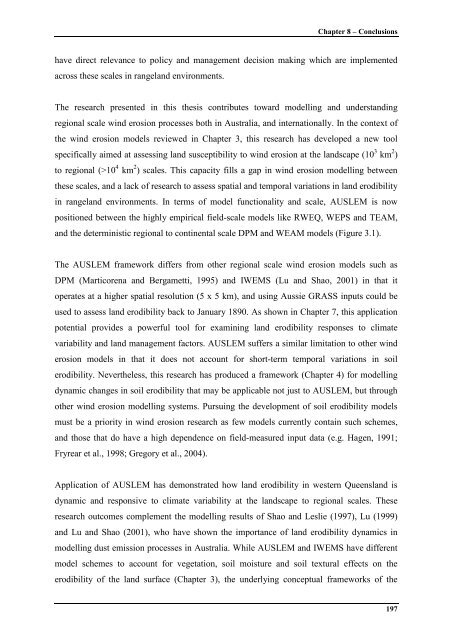Wind Erosion in Western Queensland Australia
Modelling Land Susceptibility to Wind Erosion in Western ... - Ninti One
Modelling Land Susceptibility to Wind Erosion in Western ... - Ninti One
You also want an ePaper? Increase the reach of your titles
YUMPU automatically turns print PDFs into web optimized ePapers that Google loves.
Chapter 8 – Conclusionshave direct relevance to policy and management decision mak<strong>in</strong>g which are implementedacross these scales <strong>in</strong> rangeland environments.The research presented <strong>in</strong> this thesis contributes toward modell<strong>in</strong>g and understand<strong>in</strong>gregional scale w<strong>in</strong>d erosion processes both <strong>in</strong> <strong>Australia</strong>, and <strong>in</strong>ternationally. In the context ofthe w<strong>in</strong>d erosion models reviewed <strong>in</strong> Chapter 3, this research has developed a new toolspecifically aimed at assess<strong>in</strong>g land susceptibility to w<strong>in</strong>d erosion at the landscape (10 3 km 2 )to regional (>10 4 km 2 ) scales. This capacity fills a gap <strong>in</strong> w<strong>in</strong>d erosion modell<strong>in</strong>g betweenthese scales, and a lack of research to assess spatial and temporal variations <strong>in</strong> land erodibility<strong>in</strong> rangeland environments. In terms of model functionality and scale, AUSLEM is nowpositioned between the highly empirical field-scale models like RWEQ, WEPS and TEAM,and the determ<strong>in</strong>istic regional to cont<strong>in</strong>ental scale DPM and WEAM models (Figure 3.1).The AUSLEM framework differs from other regional scale w<strong>in</strong>d erosion models such asDPM (Marticorena and Bergametti, 1995) and IWEMS (Lu and Shao, 2001) <strong>in</strong> that itoperates at a higher spatial resolution (5 x 5 km), and us<strong>in</strong>g Aussie GRASS <strong>in</strong>puts could beused to assess land erodibility back to January 1890. As shown <strong>in</strong> Chapter 7, this applicationpotential provides a powerful tool for exam<strong>in</strong><strong>in</strong>g land erodibility responses to climatevariability and land management factors. AUSLEM suffers a similar limitation to other w<strong>in</strong>derosion models <strong>in</strong> that it does not account for short-term temporal variations <strong>in</strong> soilerodibility. Nevertheless, this research has produced a framework (Chapter 4) for modell<strong>in</strong>gdynamic changes <strong>in</strong> soil erodibility that may be applicable not just to AUSLEM, but throughother w<strong>in</strong>d erosion modell<strong>in</strong>g systems. Pursu<strong>in</strong>g the development of soil erodibility modelsmust be a priority <strong>in</strong> w<strong>in</strong>d erosion research as few models currently conta<strong>in</strong> such schemes,and those that do have a high dependence on field-measured <strong>in</strong>put data (e.g. Hagen, 1991;Fryrear et al., 1998; Gregory et al., 2004).Application of AUSLEM has demonstrated how land erodibility <strong>in</strong> western <strong>Queensland</strong> isdynamic and responsive to climate variability at the landscape to regional scales. Theseresearch outcomes complement the modell<strong>in</strong>g results of Shao and Leslie (1997), Lu (1999)and Lu and Shao (2001), who have shown the importance of land erodibility dynamics <strong>in</strong>modell<strong>in</strong>g dust emission processes <strong>in</strong> <strong>Australia</strong>. While AUSLEM and IWEMS have differentmodel schemes to account for vegetation, soil moisture and soil textural effects on theerodibility of the land surface (Chapter 3), the underly<strong>in</strong>g conceptual frameworks of the197
















